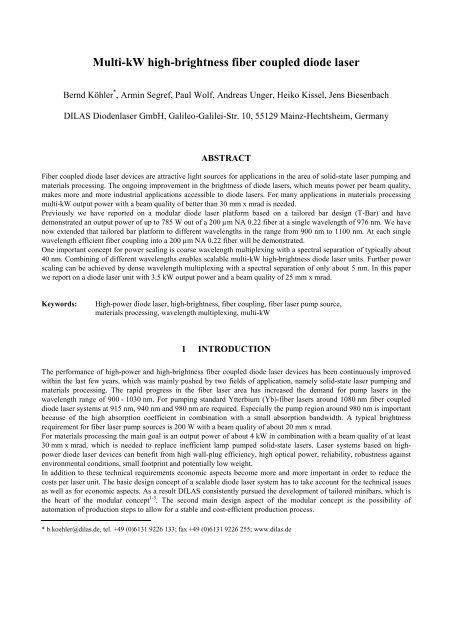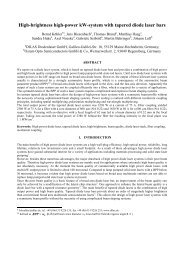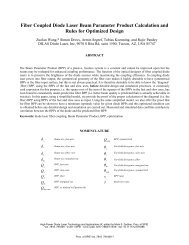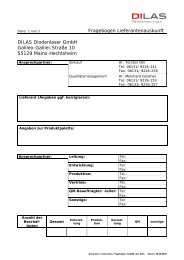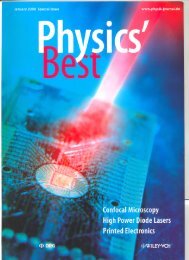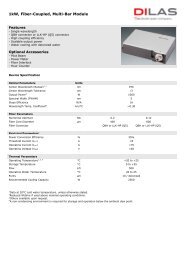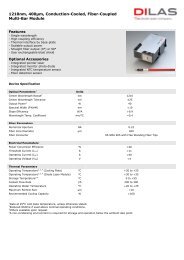Multi-kW high-brightness fiber coupled diode laser - DILAS
Multi-kW high-brightness fiber coupled diode laser - DILAS
Multi-kW high-brightness fiber coupled diode laser - DILAS
Create successful ePaper yourself
Turn your PDF publications into a flip-book with our unique Google optimized e-Paper software.
<strong>Multi</strong>-<strong>kW</strong> <strong>high</strong>-<strong>brightness</strong> <strong>fiber</strong> <strong>coupled</strong> <strong>diode</strong> <strong>laser</strong><br />
Bernd Köhler * , Armin Segref, Paul Wolf, Andreas Unger, Heiko Kissel, Jens Biesenbach<br />
<strong>DILAS</strong> Dioden<strong>laser</strong> GmbH, Galileo-Galilei-Str. 10, 55129 Mainz-Hechtsheim, Germany<br />
ABSTRACT<br />
Fiber <strong>coupled</strong> <strong>diode</strong> <strong>laser</strong> devices are attractive light sources for applications in the area of solid-state <strong>laser</strong> pumping and<br />
materials processing. The ongoing improvement in the <strong>brightness</strong> of <strong>diode</strong> <strong>laser</strong>s, which means power per beam quality,<br />
makes more and more industrial applications accessible to <strong>diode</strong> <strong>laser</strong>s. For many applications in materials processing<br />
multi-<strong>kW</strong> output power with a beam quality of better than 30 mm x mrad is needed.<br />
Previously we have reported on a modular <strong>diode</strong> <strong>laser</strong> platform based on a tailored bar design (T-Bar) and have<br />
demonstrated an output power of up to 785 W out of a 200 µm NA 0.22 <strong>fiber</strong> at a single wavelength of 976 nm. We have<br />
now extended that tailored bar platform to different wavelengths in the range from 900 nm to 1100 nm. At each single<br />
wavelength efficient <strong>fiber</strong> coupling into a 200 µm NA 0.22 <strong>fiber</strong> will be demonstrated.<br />
One important concept for power scaling is coarse wavelength multiplexing with a spectral separation of typically about<br />
40 nm. Combining of different wavelengths enables scalable multi-<strong>kW</strong> <strong>high</strong>-<strong>brightness</strong> <strong>diode</strong> <strong>laser</strong> units. Further power<br />
scaling can be achieved by dense wavelength multiplexing with a spectral separation of only about 5 nm. In this paper<br />
we report on a <strong>diode</strong> <strong>laser</strong> unit with 3.5 <strong>kW</strong> output power and a beam quality of 25 mm x mrad.<br />
Keywords:<br />
High-power <strong>diode</strong> <strong>laser</strong>, <strong>high</strong>-<strong>brightness</strong>, <strong>fiber</strong> coupling, <strong>fiber</strong> <strong>laser</strong> pump source,<br />
materials processing, wavelength multiplexing, multi-<strong>kW</strong><br />
1 INTRODUCTION<br />
The performance of <strong>high</strong>-power and <strong>high</strong>-<strong>brightness</strong> <strong>fiber</strong> <strong>coupled</strong> <strong>diode</strong> <strong>laser</strong> devices has been continuously improved<br />
within the last few years, which was mainly pushed by two fields of application, namely solid-state <strong>laser</strong> pumping and<br />
materials processing. The rapid progress in the <strong>fiber</strong> <strong>laser</strong> area has increased the demand for pump <strong>laser</strong>s in the<br />
wavelength range of 900 - 1030 nm. For pumping standard Ytterbium (Yb)-<strong>fiber</strong> <strong>laser</strong>s around 1080 nm <strong>fiber</strong> <strong>coupled</strong><br />
<strong>diode</strong> <strong>laser</strong> systems at 915 nm, 940 nm and 980 nm are required. Especially the pump region around 980 nm is important<br />
because of the <strong>high</strong> absorption coefficient in combination with a small absorption bandwidth. A typical <strong>brightness</strong><br />
requirement for <strong>fiber</strong> <strong>laser</strong> pump sources is 200 W with a beam quality of about 20 mm x mrad.<br />
For materials processing the main goal is an output power of about 4 <strong>kW</strong> in combination with a beam quality of at least<br />
30 mm x mrad, which is needed to replace inefficient lamp pumped solid-state <strong>laser</strong>s. Laser systems based on <strong>high</strong>power<br />
<strong>diode</strong> <strong>laser</strong> devices can benefit from <strong>high</strong> wall-plug efficiency, <strong>high</strong> optical power, reliability, robustness against<br />
environmental conditions, small footprint and potentially low weight.<br />
In addition to these technical requirements economic aspects become more and more important in order to reduce the<br />
costs per <strong>laser</strong> unit. The basic design concept of a scalable <strong>diode</strong> <strong>laser</strong> system has to take account for the technical issues<br />
as well as for economic aspects. As a result <strong>DILAS</strong> consistently pursued the development of tailored minibars, which is<br />
the heart of the modular concept 1-3 . The second main design aspect of the modular concept is the possibility of<br />
automation of production steps to allow for a stable and cost-efficient production process.<br />
* b.koehler@dilas.de, tel. +49 (0)6131 9226 133; fax +49 (0)6131 9226 255; www.dilas.de
2 MODULAR DIODE LASER CONCEPT<br />
In this section we present some general design aspects of the modular <strong>diode</strong> <strong>laser</strong> concept which enables power scaling<br />
of <strong>fiber</strong> <strong>coupled</strong> <strong>high</strong>-<strong>brightness</strong> <strong>diode</strong> <strong>laser</strong> systems with output powers from 100 W up to several <strong>kW</strong>.<br />
2.1 Basic <strong>laser</strong> unit<br />
The modular concept has already been described in previous publications 1 . The basic subunit is a tailored minibar, whose<br />
pitch, emitter size and number of emitters is chosen such that a desired beam quality in slow-axis direction can be<br />
realized without using sophisticated beam shaping optics. The optical design concept is based on fast-axis collimator<br />
(FAC) and slow-axis collimator (SAC) lenses followed by only one additional focusing optic for efficient coupling into a<br />
<strong>fiber</strong> with 200 µm core and a numerical aperture of 0.22. The lateral structure of the tailored minibar is defined by<br />
5 emitters with an emitter width of 100 µm spaced by a pitch of 1000 µm.The advantage of such a low fill factor bar is a<br />
reduced thermal crosstalk between the emitters, which is illustrated in the left part of Fig. 1. The thermal simulation for<br />
the low fill factor bar shows negligible thermal crosstalk between the emitters which increases reliability and potential<br />
output power per emitter.<br />
The next step of the modular concept is to arrange seven tailored minibars on one baseplate in combination with FAC<br />
and SAC for each bar. In addition mirrors are implemented on the baseplate to build an optical stack. All optical<br />
components are mounted automatically to ensure very <strong>high</strong> reproducibility and an efficient production process. As a<br />
result pointing errors are minimized which is important for beam quality with regard to <strong>fiber</strong> coupling or wavelength<br />
stabilization, which is possible by using only one volume holographic grating (VHG) for the whole baseplate. Another<br />
important design aspect is that the cooling strategy allows the use of industrial water for the bottom-cooled baseplate.<br />
Fig. 1: Thermal simulation of a tailored minibar with reduced number of emitters (left diagram). Measurement of the beam caustic for<br />
the baseplate with resulting beam quality of 16.4 mm x mrad (M 2 =53) in slow-axis direction and 6.6 mm x mrad (M 2 =21) in fast-axis<br />
direction, respectively (right diagram).<br />
The baseplate with seven minibars is characterized by an output power of about 260 W at a current of 40 A and an<br />
overall beam quality of better than 20 mm x mrad enabling efficient coupling into a 200 µm NA 0.22 <strong>fiber</strong>. The right<br />
part of Fig. 1 shows a measurement of the beam quality for the baseplate. The resulting beam qualities are<br />
16.4 mm x mrad (M 2 = 53) for the slow-axis direction and 6.6 mm x mrad (M 2 = 21) for the fast-axis direction,<br />
respectively. The central wavelength of the base plate is 976 nm with a spectral width of about 4 nm (90 % power<br />
content). Optionally - by using one common VHG for the whole base plate - the central wavelength can be fixed and the<br />
spectral width can be reduced down to 0.5 nm (90 % power content). Furthermore it is worth noting that the <strong>laser</strong> light of<br />
the base plate is linearly polarized.
2.2 Modular Laser Concept<br />
The basic idea of the modular <strong>laser</strong> concept is to use the standard <strong>laser</strong> unit described in the previous section as a<br />
building block for a variety of <strong>laser</strong>s with different output powers and beam qualities. According to the modular design<br />
principle the baseplates can be easily combined to scale output power, which is realized optically by spatial and / or<br />
polarization multiplexing. The advantage of a common baseplate as basic building block for the modular system is that<br />
the baseplate can be produced in <strong>high</strong> volume. The production process for the baseplate is <strong>high</strong>ly automated which leads<br />
to a cost-efficient and reliable building block with <strong>high</strong> repeatability regarding optical properties.<br />
The modular concept is schematically shown in Fig. 2. Starting with a one-plate unit with 200 W output power for a<br />
200 µm <strong>fiber</strong> (NA 0.22) we end up with a <strong>laser</strong> system consisting of 8 baseplates resulting in 1.7 <strong>kW</strong> output power for a<br />
400 µm <strong>fiber</strong> (NA 0.22) at one single wavelength.<br />
.<br />
Fig. 2: Schematic drawing of modular <strong>diode</strong> <strong>laser</strong> concept based on one common baseplate.<br />
Detailed investigations for the different configurations have already been presented 1 . The results have shown that<br />
combining four baseplates still allows efficient <strong>fiber</strong> coupling into a 200 µm <strong>fiber</strong> with NA 0.22. However, further power<br />
scaling by adding even more baseplates is at the cost of the overall beam quality, which reduces the coupling efficiency<br />
for a 200 µm <strong>fiber</strong> with NA 0.22. Power scaling without affecting the beam quality is possible by using wavelength<br />
multiplexing to combine multiple units. The basic principle of wavelength combining is shown in Fig. 3 for several<br />
four-plate units. The drawback of the concept is that the overall spectral <strong>brightness</strong> is reduced, which would be<br />
disadvantageous for pumping applications but which is not important for many applications in materials processing.<br />
Fig. 3: Schematic setup of wavelength multiplexing of different <strong>laser</strong> units
Wavelength combination is realized by coarse multiplexing with appropriate dielectric mirrors. For power scaling it is<br />
desirable to keep the wavelength separation between different units small, because the minimum wavelength separation<br />
defines the number of units that can be combined within a given spectral range. Parameters which are important for the<br />
efficiency of wavelength combination are the spectral width of the individual modules and the transmission<br />
characteristics of the dielectric mirrors. Additional parameters are the angular divergence of the <strong>laser</strong> units in<br />
combination with the angle of incidence for the dielectric mirror.<br />
One example of a typical transmission curve for such a dielectric mirror is shown in Fig. 4. It is important to notice that<br />
the transmission curve is dependent on the polarization. The transmission characteristics are shown as a function of<br />
wavelength for both polarization directions. The split of the transmission curves defines the minimum allowable<br />
wavelength separation for combining unpolarized <strong>laser</strong> sources. In addition the wavelength shift as a function of current<br />
and temperature further limits the minimum possible wavelength separation. The example of the transmission curve<br />
shown in Fig. 4 would allow the combination of two <strong>laser</strong> units with a wavelength separation of about 30 nm. Typical<br />
spectral distributions of the four-plate units are also illustrated in Fig. 4 for two different wavelengths of 940 nm and<br />
980 nm. The edge steepness of the transmission curves can be optimized by reducing the angle of incidence, but for<br />
small angles of incidence the mechanical setup becomes more complex.<br />
Fig. 4: Example of a dielectric mirror for wavelength combination. Transmission values are shown for both polarization values as a<br />
function of wavelength (black). Typical spectra of unstabilized <strong>laser</strong> sources at two different wavelengths of 940 nm (green) and<br />
980 nm (red) in comparison to a spectrum of a wavelength stabilized <strong>laser</strong> source at 974 nm (blue).<br />
Increasing the number of spectrally combined units within a given wavelength range can be achieved by using<br />
wavelength stabilized systems, which benefit from a reduced spectral width and a significantly reduced sensitivity of the<br />
wavelength to temperature and current. One example of a spectrally stabilized <strong>laser</strong> unit is shown in Fig. 4 (blue) in<br />
comparison to spectra of unstabilized <strong>laser</strong> units. In combination with appropriate dielectric mirrors or volume Bragg<br />
gratings dense wavelength multiplexing with up to four channels within 12 nm can be realized 4,5 . Dense wavelength<br />
beam combining can also be realized with an external cavity consisting of a lens, a diffraction grating and an output<br />
coupler. Such <strong>diode</strong> <strong>laser</strong> systems have been reported recently with output powers in the <strong>kW</strong> range in combination with<br />
very <strong>high</strong> <strong>brightness</strong> 6 .
3 RESULTS<br />
In this section we will present a detailed characterization of the multi-<strong>kW</strong> <strong>high</strong>-<strong>brightness</strong> <strong>diode</strong> <strong>laser</strong> system, which<br />
includes the results of the individual subunits at different wavelengths, as well as the investigation of the complete<br />
system with wavelength combination. The subunits consist of four baseplates with 7 bars per plate. In each case two<br />
plates are stacked optically by means of several folding mirrors. Afterwards the two resulting beams are combined by<br />
polarization coupling to enhance the <strong>brightness</strong>. As mentioned in the previous section the overall <strong>brightness</strong> of the fourplate<br />
unit still allows efficient <strong>fiber</strong> coupling into a 200 µm <strong>fiber</strong> with NA 0.22. Such units have been built at five<br />
different wavelengths of 910 nm, 940 nm, 976 nm, 1020 nm and 1060 nm.<br />
3.1 Laser units at different wavelengths<br />
At a central wavelength of 976 nm we have already presented results for the four-plate unit 2 . We have demonstrated<br />
775 W of optical output power for a 200 µm <strong>fiber</strong> (NA 0.22) with a spectral linewidth of 5.1 nm (90 % power content).<br />
Wavelength stabilization was possible by using only one common VHG per baseplate. The output power of the fourplate<br />
unit with VHG was 690 W with a central wavelength of 976.8 nm and a spectral width of only 0.7 nm (90 % power<br />
content) 2 . For many industrial applications a numerical aperture below 0.22 is desirable, so we have realized an optional<br />
design for a numerical aperture of 0.12. One advantage of low-NA systems is the reduction of aberrations in the optical<br />
system. Of course, the NA-reduction is at the cost of the <strong>fiber</strong> diameter because the overall beam parameter product<br />
remains unchanged.<br />
Fig. 5 shows the experimental results for the four-plate unit at a wavelength of 976 nm with a low numerical aperture.<br />
We have realized an output power of 840 W out of a 400 µm <strong>fiber</strong> with a numerical aperture of 0.12. The corresponding<br />
electro-optical efficiency was 47% at an operating current of 40 A. The right part of Fig. 5 shows the mechanical layout<br />
with dimensions of 285 x 280 x 100 mm 3 and a weight of 9.7 kg 1 .<br />
Fig. 5: Output power and electro-optical efficiency of a unit with four baseplates as function of current at a temperature of 25°C (left).<br />
The <strong>fiber</strong> is a 400 µm <strong>fiber</strong> with numerical aperture of 0.12 and the central wavelength of the <strong>laser</strong> unit is 976 nm. Mechanical<br />
dimensions are 285 x 280 x 100 mm 3 with a weight of 9.7 kg (right).<br />
For further power scaling by wavelength multiplexing we have adapted the basic concept to different wavelengths in the<br />
range from 900 nm to 1100 nm. The beam quality of the four-plate unit is about 22 mm x mrad, which allows efficient<br />
<strong>fiber</strong> coupling into a 200 µm <strong>fiber</strong> with NA 0.22 or alternatively into a 400 µm <strong>fiber</strong> with lower NA. We have used a<br />
400 µm <strong>fiber</strong> with NA 0.12, which corresponds to a beam parameter product of 24 mm x mrad. The results are<br />
summarized in Fig. 6. The left part shows the output power as a function of current for each unit. The maximum output<br />
power was achieved for the 1020 nm unit with 950 W at an operating current of 45 A. Similar output power has been<br />
measured for the 980 nm unit with 934 W, whereas the other units show slightly less power down to 775 W for the<br />
940 nm unit. The reason for the variation in output power is explained by different electro-optical characteristics of the<br />
<strong>diode</strong> <strong>laser</strong> bars at each wavelength, like threshold current, slope efficiency and far field divergencies.
In the right part of Fig. 6 typical spectra are shown exemplarily for the 940 nm unit and the 980 nm unit, respectively.<br />
Typical spectral widths of such units without additional wavelength stabilization are about 5 nm (90 % power content).<br />
Fig. 6: Output power of different four-plate units as function of current at a temperature of 20°C (left). The wavelengths of the<br />
individual units are 915 nm, 940 nm, 980 nm, 1020 nm and 1060 nm, respectively. The <strong>fiber</strong> has a 400 µm core with a numerical<br />
aperture of 0.12. Typical spectra of the 940 nm unit and the 980 nm unit with a spectral width of 4.8 nm and 5.5 nm (90% power<br />
value) (right).<br />
3.2 Wavelength multiplexing of base units<br />
The basic principle of beam combination by coarse wavelength multiplexing has already been described in Sect. 2.2. In<br />
this section we will present the experimental results of power scaling by spectrally combining the individual units<br />
described in the previous section. One main advantage of <strong>fiber</strong> <strong>coupled</strong> subunits is that the beam quality at the combiner<br />
input is well defined. Furthermore adding or removing subunits for power scaling is easy because of the fixed <strong>fiber</strong><br />
interface. The disadvantage of individual <strong>fiber</strong> <strong>coupled</strong> units is that the overall power loss is increased due to the optical<br />
elements for <strong>fiber</strong> coupling and the incoupling losses at the <strong>fiber</strong> entrance plane. Therefore also solutions without <strong>fiber</strong><br />
coupling of the subunits have to be considered. After spectrally combining the subunits the beam is <strong>coupled</strong> into a<br />
500 µm <strong>fiber</strong> with low NA 0.12, corresponding to a beam quality of 30 mm x mrad. The overall output power is shown<br />
in Fig. 7 as a function of current for 3 different duty cycles of 100 %, 50 % and 25 %.<br />
Fig. 7: Output power as a function of current of the complete system based on spectrally combined subunits The wavelengths of the<br />
individual units are 915 nm, 940 nm, 980 nm, 1020 nm and 1060 nm, respectively. The <strong>fiber</strong> has a 500 µm core with a numerical<br />
aperture of 0.12.
The maximum output power for continuous wave (cw) operation (100 % duty cycle) was 3835 W at an operating current<br />
of 45 A. For lower duty cycles thermal effects are reduced leading to a slightly <strong>high</strong>er output power of 3916 W for<br />
50 % DC and 3960 W for 25 % DC, respectively. The minor variation in output power for different duty cycles is only<br />
valid at very <strong>high</strong> output power above a current of about 40 A. For a second unit we have measured a slightly increased<br />
output power of 3921 W for continuous wave operation with an overall efficiency of nearly 40 %.<br />
Typically the <strong>fiber</strong>s which are used for low NA sources of about 0.12 are characterized by a larger NA of up to 0.22.<br />
Therefore it is important to check the real NA of the <strong>laser</strong> beam that exits the <strong>fiber</strong> end, because the NA could be<br />
increased by misaligned incoupling optics and also by bending of the <strong>fiber</strong>. Such effects would worsen the beam quality<br />
and cause potential losses in subsequent processing heads. We have measured the actual beam quality by inserting<br />
various mechanical apertures into the collimation optics after the exit of the 500 µm <strong>fiber</strong>.<br />
The results of these measurements are shown in Fig. 8. The upper left part of Fig. 8 shows the output power of the<br />
complete system with a 500 µm <strong>fiber</strong> as function of the numerical aperture. The output power decreases from 3960 W at<br />
a numerical aperture of 0.13 down to 3460 W at a numerical aperture of 0.1. The upper right part of Fig. 8 is based on<br />
the same data but illustrates the relative power content as a function of the beam quality defined by the beam parameter<br />
product. More than 97 % of the power is included within a beam parameter product of 30 mm x mrad. For a beam<br />
quality of 25 mm x mrad the value is reduced down to about 87 %, which corresponds to an output power of nearly<br />
3.5 <strong>kW</strong> with a beam quality of 25 mm x mrad.<br />
Additional measurements of the beam quality have been performed by scanning the <strong>laser</strong> beam with a rotating pinhole<br />
(FocusMonitor, PRIMES). The measured beam caustic is shown in the lower part of Fig. 8. The beam caustic<br />
measurement has been done in cw-operation at a power of 3835 W with a resulting beam quality of 26.5 mm x mrad.<br />
This value is in good agreement with the previous measurement by means of mechanical apertures.<br />
Fig. 8: Output power of the complete system with a 500 µm <strong>fiber</strong> as function of NA (top left). Relative power content of the <strong>fiber</strong><br />
<strong>coupled</strong> system with 500 µm <strong>fiber</strong> as a function of the beam quality (top right). Beam caustic measurement of the complete system at a<br />
current of 45 A in cw-operation (bottom).
SUMMARY AND CONCLUSION<br />
In conclusion we have presented a modular <strong>diode</strong> <strong>laser</strong> concept for building <strong>high</strong>ly efficient <strong>fiber</strong> <strong>coupled</strong> <strong>diode</strong> <strong>laser</strong><br />
units with multi-<strong>kW</strong> output power and a beam quality of 25 – 30 mm x mrad. The main idea of the concept is to use the<br />
previously presented basic building block for all <strong>laser</strong> units, which enables automated and cost-efficient production with<br />
very <strong>high</strong> repeatability of optical properties. Power scaling in the multi-<strong>kW</strong> range was achieved by extending the concept<br />
of the basic building block to other wavelengths and combining the <strong>laser</strong> units by coarse wavelength multiplexing.<br />
In detail we have presented five different <strong>fiber</strong> <strong>coupled</strong> <strong>laser</strong> units (400 µm NA 0.12) within a wavelength range of<br />
900 - 1100 nm with output powers from 775 W at a wavelength of 940 nm up to 950 W at 1020 nm. Power scaling in the<br />
multi-<strong>kW</strong> range was realized by coarse wavelength multiplexing with dielectric mirrors resulting in a maximum output<br />
power of 3921 W for continuous wave operation (500 µm NA 0.12). Measurements of the beam quality have shown that<br />
more than 97 % of the power was included within a beam parameter product of 30 mm x mrad. For a beam quality of<br />
25 mm x mrad we have measured an output power of 3460 W.<br />
Further power scaling is possible by using dense wavelength multiplexing which will enable the building of <strong>laser</strong> units<br />
with even <strong>high</strong>er output power while maintaining the beam quality.<br />
ACKNOWLEDGEMENT<br />
A part of this work was sponsored by the German Federal Ministry of Education and Research (BMBF) within the<br />
German national funding initiative “Integrated Optical Components for High Power Laser Beam Sources (INLAS)”. In<br />
addition part of this work was supported with funding from the “Leadership in Fibre Laser Technology (LIFT)” project<br />
under the 7 th Framework Programme of the European Commission.<br />
REFERENCES<br />
1. B. Köhler, S. Ahlert, A. Bayer, et al., "Scalable <strong>high</strong>-power and <strong>high</strong>-<strong>brightness</strong> <strong>fiber</strong> <strong>coupled</strong> <strong>diode</strong> <strong>laser</strong> devices",<br />
Proceedings of SPIE Vol. 8241, 824108 (2012)<br />
2. Wolf, P., Köhler, B., Rotter, K., et al., "High-power <strong>high</strong>-<strong>brightness</strong> and low-weight <strong>fiber</strong> <strong>coupled</strong> <strong>diode</strong> <strong>laser</strong><br />
device", Proceedings of SPIE Vol. 7918, 79180O (2011)<br />
3. Haag, M., Köhler, B., Biesenbach, J., et al., "Novel <strong>high</strong>-<strong>brightness</strong> <strong>fiber</strong> <strong>coupled</strong> <strong>diode</strong> <strong>laser</strong> device", Proceedings<br />
of SPIE Vol. 6456, 64560T (2007)<br />
4. S. Heinemann, B. Lewis, K. Michaelis and T. Schmidt, "Very <strong>high</strong> <strong>brightness</strong> <strong>diode</strong> <strong>laser</strong>", Proceedings of SPIE<br />
Vol. 8241, 824101(2012)<br />
5. C. Wessling, M. Traub and D. Hoffmann, "Fiber <strong>coupled</strong> <strong>diode</strong> <strong>laser</strong> of <strong>high</strong> spectral and spatial beam quality with<br />
<strong>kW</strong> class output power", Proceedings of SPIE Vol. 6456, 645611 (2007)<br />
6. R. K. Huang, B. Chann, J. Burgess, M. Kaiman, R. Overman, et al., "Direct <strong>diode</strong> <strong>laser</strong>s with comparable beam<br />
quality to <strong>fiber</strong>, CO2, and solid state <strong>laser</strong>s", Proceedings of SPIE Vol. 8241, 824102 (2012)


